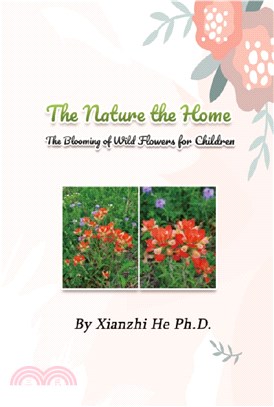大自然的家:北美野花集錦(國際英文版)
商品資訊
ISBN13:9781647841874
出版社:漢世紀數位文化EHGBooks
作者:何顯志
出版日:2023/01/01
裝訂:平裝
規格:22.8cm*15.2cm (高/寬)
定價
:NT$ 2100 元優惠價
:79 折 1659 元
無庫存,下單後進貨(採購期約4~10個工作天)
下單可得紅利積點:49 點
商品簡介
作者簡介
目次
相關商品
商品簡介
本書收錄了來自地球村的 111 種野花集錦,包含 220 多幅美麗的野花照片,在植物學上的物種共計分為36個植物科,圖文並茂的方式介紹了每種野花的花、葉、莖之一般結構、開花時間、產地,以及可食用性、毒性,部分也包含了在傳統草藥中的用途。書中針對植物特定術語提供了生物詞彙表,水生野花和寄生野花因其典型特徵而分別分組,同時也介紹了每個植物科與其共同特徵的總體情況。
本書所有花卉照片都是在美國德州北部所拍攝取得,這本相冊中的大部分野花物種都原產於美洲,它們照亮了我們在德州與全美的綠色道路,也為生活帶來斑斕璀璨的色彩,為有興趣接觸野花生態的青少年或成年,提供一個入門的探索指南。
This photo book is intended for helping children to become familiar with the wildflowers and the general plant related terms. In this photo book, more than 220 beautiful wildflower pictures taken from 111 wildflower species are included.
The plant species are botanically classified into 36 plant families. Each wildflower species is briefly described about its general structure of flowers, leaves, stems, the blooming time, native place, and the edibility, toxicity or uses in traditional herbal medicine if it has. The aquatic and parasitic wildflowers are grouped separately for their typical characteristics. Brief description of each plant family is also included to provide a general picture of the common characteristics in the plant family. A glossary for the plant specific terms in the text is prepared.
Although all the pictures were taken in North Texas, most of the wildflower species in this photo book are native to Americas. They brighten our life in Texas, but also in other parts of United State, and bring the pleasure to us when we exercise in the morning or drive on the road. This photo book is prepared for children, but it will be also useful for adults who are interested in wildflowers.
本書所有花卉照片都是在美國德州北部所拍攝取得,這本相冊中的大部分野花物種都原產於美洲,它們照亮了我們在德州與全美的綠色道路,也為生活帶來斑斕璀璨的色彩,為有興趣接觸野花生態的青少年或成年,提供一個入門的探索指南。
This photo book is intended for helping children to become familiar with the wildflowers and the general plant related terms. In this photo book, more than 220 beautiful wildflower pictures taken from 111 wildflower species are included.
The plant species are botanically classified into 36 plant families. Each wildflower species is briefly described about its general structure of flowers, leaves, stems, the blooming time, native place, and the edibility, toxicity or uses in traditional herbal medicine if it has. The aquatic and parasitic wildflowers are grouped separately for their typical characteristics. Brief description of each plant family is also included to provide a general picture of the common characteristics in the plant family. A glossary for the plant specific terms in the text is prepared.
Although all the pictures were taken in North Texas, most of the wildflower species in this photo book are native to Americas. They brighten our life in Texas, but also in other parts of United State, and bring the pleasure to us when we exercise in the morning or drive on the road. This photo book is prepared for children, but it will be also useful for adults who are interested in wildflowers.
作者簡介
何顯志博士畢業於華南農業大學園藝與植物病理學專業,1989年赴美深造,在懷俄明大學獲得植物科學博士學位後,他繼續在喬治亞大學、塞繆爾羅伯茨諾貝爾基金會和北卡羅來納州立大學從事研究20多年。他的研究涉及植物病害、植物化學物質的生物合成和花色色素,在同行評審期刊上發表了 30 多篇文章,並持有美國專利。
何博士退休後搬到了美國德州北部地區。在這個快速發展的大都市裡,野花幾乎全年都在路邊、湖邊、樹林下和野外盛開;然而,他也意識到,樹木和土地的資源每天都在被建築物和房屋取代,在房子建得越來越大之時,越來越多的樹木同時被砍伐消失。因為他深切了解植物與自然對人類生命和可持續發展的重要性,何博士自 2019 年起開始製作野花相冊,希望引起下一代孩子們的注意,激發他們對植物科學和自然保護的興趣。作者過去幾年拍攝數千張野花照片,今自111種植物中精心挑選了 222 張野花照片,將它們彙編成這本全彩的花卉小冊,簡要介紹了每一種植物,提供讀者一個對植物花卉的入門指南。
Dr. Xianzhi He came to the United States for further education in 1989 with an educational background in horticulture and plant pathology from South China Agricultural University. After received his Ph. D. degree in plant science from the University of Wyoming, he continued to do research in University of Georgia, The Samuel Roberts Noble Foundation and North Carolina State University for more than 20 years. His research was related to plant disease, biosynthesis of plant chemicals and pigments of flower color, with more than 30 articles published in peer-reviewed journals and holding a US patent.
After retirement he moved to the area of North Texas. The wildflowers bloom along roadsides, by the lakes, under woods and in wild area almost year round in this fast-growing metroplex. However, he also realizes that trees and lands are being turned into buildings and houses every day. Houses are built to be bigger, bigger and bigger, and trees, trees and trees are being cut down. Knowing that plants and the conservation of nature are important to human life and sustainable development, he started to prepare a wildflower photo book in 2019 in order to bring the wildflowers to children’s attention and inspire their interest in plant science and natural conservation. From thousands of wildflower pictures taken in the last few years, he thoughtfully selected 222 of them from 111 plant species and compiled them into this photo book with a brief description of each plant species. We hope that this photo book will be helpful for the kids to become acquainted with the wildflowers around us.
何博士退休後搬到了美國德州北部地區。在這個快速發展的大都市裡,野花幾乎全年都在路邊、湖邊、樹林下和野外盛開;然而,他也意識到,樹木和土地的資源每天都在被建築物和房屋取代,在房子建得越來越大之時,越來越多的樹木同時被砍伐消失。因為他深切了解植物與自然對人類生命和可持續發展的重要性,何博士自 2019 年起開始製作野花相冊,希望引起下一代孩子們的注意,激發他們對植物科學和自然保護的興趣。作者過去幾年拍攝數千張野花照片,今自111種植物中精心挑選了 222 張野花照片,將它們彙編成這本全彩的花卉小冊,簡要介紹了每一種植物,提供讀者一個對植物花卉的入門指南。
Dr. Xianzhi He came to the United States for further education in 1989 with an educational background in horticulture and plant pathology from South China Agricultural University. After received his Ph. D. degree in plant science from the University of Wyoming, he continued to do research in University of Georgia, The Samuel Roberts Noble Foundation and North Carolina State University for more than 20 years. His research was related to plant disease, biosynthesis of plant chemicals and pigments of flower color, with more than 30 articles published in peer-reviewed journals and holding a US patent.
After retirement he moved to the area of North Texas. The wildflowers bloom along roadsides, by the lakes, under woods and in wild area almost year round in this fast-growing metroplex. However, he also realizes that trees and lands are being turned into buildings and houses every day. Houses are built to be bigger, bigger and bigger, and trees, trees and trees are being cut down. Knowing that plants and the conservation of nature are important to human life and sustainable development, he started to prepare a wildflower photo book in 2019 in order to bring the wildflowers to children’s attention and inspire their interest in plant science and natural conservation. From thousands of wildflower pictures taken in the last few years, he thoughtfully selected 222 of them from 111 plant species and compiled them into this photo book with a brief description of each plant species. We hope that this photo book will be helpful for the kids to become acquainted with the wildflowers around us.
目次
Table of content
Introduction
Preface
Author
Flower Structure
Plant classification
▲Pea family (Leguminosae)▲
①Common vetch (Vicia sativa)
②Eastern redbud (Cercis canadensis)
③Fodder vetch (Vicia villosa)
④Ground plum (Astragalus crassicarpus)
⑤Honey mesquite (Prosopis glandulosa)
⑥Powderpuff (Mimosa strigillosa)
⑦Roundhead prairie clover (Dalea multiflora)
⑧Sensitive briar (Mimosa quadrivalvis)
⑨Sleeping plant (Chamaecrista fasciculata)
⑩Texas bluebonnet (Lupinus texensis)
⑪White ball acacia (Acaciella angustissima)
⑫White clover (Trifolium repens)
⑬Yellow puff (Neptunia lutea)
⑭Yellow sweet clover (Melilotus officinalis)
▲Sunflower family (Astereraceae)▲
①American basket flower (Centaurea americanus)
②Bitter sneeze weed (Helenium amarum)
③Black eyed Susan (Rudbeckia fulgida)
④Carolina woolly white (Hymenopappus scabiosaeus)
⑤Clasping coneflower (Dracopis amplexicaulis)
⑥Common dandelion (Taraxacum officinale)
⑦Common yarrow (Achillea millefolium)
⑧Cretan weed (Hedypnois rhagadioloides)
⑨Golden tickseed (Coreopsis tinctoria)
⑩Indian blanket (Gaillardia pulchella)
⑪Mexican hat (Ratibida columnifera)
⑫Musk thistle (Carduus nutans)
⑬Oxford ragwort (Senecio squalidus)
⑭Prairie fleabane (Erigeron strigosus)
⑮Prickly lettuce (Lactuca serriola)
⑯Stiff green thread (Thelesperma filifolium)
⑰Texas false dandelion (Pyrrhopappus pauciflorus)
⑱Texas thistle (Cirsium texanum)
⑲Tuberous indian plantain (Arnoglossum plantagineum)
⑳Western ironweed (Vernonia baldwinii)
Yellow goat’s beard (Tragopogon dubius)
▲Acanthus family (Acanthaceae)▲
①Violet wild petunia (Ruellia nudiflora)
▲Amaryllis family (Amaryllidaceae)▲
①Brazos rain lily (Zephyranthes chlorosolen)
②Canadian garlic (Allium canadense)
③False garlic (Nothoscordum bivalve)
④Rush daffodil (Narcissus jonquilla)
⑤White rain lily (Zephyranthes candida)
⑥Wild onion (Allium drummondii)
▲Aquatic plant▲
①Narrowleaf cattail (Typha angustifolia)
②Pickerel weed (Pontederia cordata)
③Water primrose (Ludwigia grandiflora)
▲Asparagus family (Asparagaceae)▲
①Common yucca (Yucca filamentosa)
②Wild hyacinth (Camassia scilloides)
▲Bignonia family (Bignoniaceae)▲
①Cigar tree (Catalpa bignonioides)
▲Borage family (Boraginaceae)▲
①Indian heliotrope (Heliotropium indicum)
②Narrowleaf stone seed (Lithospermum incisum)
▲Buttercup family (Ranunculaceae)▲
①Carolina larkspur (Delphinium carolinianum)
②Hair buttercup (Ranunculus sardous)
③Sweet autumn clematis (Clematis terniflora)
④Ten petal thimble weed (Anemone benlandieri)
▲Cabbage family (Brassicaceae)▲
①Cloth-of-gold (Physaria gracilis)
②Wild mustard (Sinapis arvensis)
▲Cactus family (Cactaceae)▲
①Indian fig (Opuntia humifusa)
▲Carrot family (Apiaceae)▲
①Common hedge parsley (Torilis arvensis)
②Wild carrot (Daucus carota)
▲Dayflower family (Commelinaceae)▲
①White mouth dayflower (Commelina erecta)
▲Dogbane family (Apocynaceae)▲
①Blood flower (Asclepias curassavica)
②Green antelope horn (Asclepias viridis)
▲Evening primrose family (Onagraceae)▲
①Evening primrose (Oenothera speciosa)
②Scarlet bee blossom (Oenothera suffrutescens)
▲Gentian family (Gentianaceae)▲
①Branched centaury (Centaurium pulchellum)
②Prairie rose gentian (Sabatia campestris)
▲Geranium family (Geraniaceae)▲
①Redstem stork’s bill (Erodium cicutarium)
▲Honeysuckle family (Caprifoliaceae)▲
①Dwarf pincushion flower (Scabiosa columbaria)
②Golden and silver honeysuckle (Lonicera japonica)
③Trumpet honeysuckle (Lonicera sempervirens)
▲Iris family (Iridaceae)▲
①Annual blue-eyed grass (Sisyrinchium rosulatum)
②Celestial lily (Nemastylis geminiflora)
③Roadside blue-eyed grass (Sisyrinchium langloisii)
▲Madder family (Rubiaceae)▲
①Diamond flower (Stenaria nigricans)
②Virginia button weed (Diodia virginiana)
▲Mallow family (Malvaceae)▲
①Light poppy mallow (Callirhoe alcaeoides)
②Wine cup (Callirhoe digitata)
▲Miner’s lettuce family (Montiaceae)▲
①Virginia spring beauty (Claytonia virginica)
▲Mint family (Lamiaceae)▲
①Blue sage (Salvia azurea)
②Common henbit (Lamium amplexicaule)
③Lemon mint (Monarda citriodora)
④Wood sage (Teucrium canadense)
▲Moring glory family (Convolvulaceae)▲
①Field bindweed (Convolvulus arvensis)
②Heavenly blue morning glory (Ipomoea tricolor)
③Purple bindweed (Ipomoea cordatotriloba)
④Texas bindweed (Convolvulus equitans)
▲Moschatel family (Adoxaceae)▲
①Linden arrow wood (Viburnum dilatatum)
▲Nightshade family (Solanaceae)▲
①Buffalo bur nightshade (Solanum rostratum)
②Silver leaf nightshade (Solanum elaeagnifolium)
▲Oliver family (Oleaceae)▲
①Chinese privet (Ligustrum sinense)
▲Parasitic plants▲
①Heme broomrape (Phelipanche nana)
②Purple false foxglove (Agalinis purpurea)
③Texas indian paintbrush (Castilleja indivisa)
④Trailing krameria (Krameria lanceolata)
▲Passion flower family (Passifloraceae)▲
①Purple passion flower (Passiflora incarnata)
②Yellow passion flower (Passiflora lutea)
▲Phlox family (Polemoniaceae)▲
①Prairie phlox (Phlox pilosa)
▲Pink family (Caryophyllaceae)▲
①Common catchfly (Silene gallica)
②Sticky mouse-ear chickweed (Cerastium glomeratum)
▲Plantain family (Plantaginaceae)▲
①Bird-eyed speedwell (Veronica persica)
②Prairie beardtongue (Penstemon cobaea)
▲Pokeweed family (Phytolaccaceae)▲
①American pokeweed (Phytolacca americana)
▲Rose family (Rosaceae)▲
①Black thorn (Prunus spinosa)
②Sawtooth blackberry (Rubus argutus)
▲Spurge family (Euphorbiaceae)▲
①Ghost weed (Euphorbia marginate)
②Texas bull nettle (Cnidoscolus texanus)
▲Verbena family (Verbenaceae)▲
①Prairie verbena (Glandularia bipinnatifida)
②Texas frog fruit (Phyta nodiflora)
▲Violet family (Violaceae)▲
①American field pansy (Viola bicolor)
▲Wood sorrel family (Oxalidaceae)▲
①Common yellow wood sorrel (Oxalis stricta)
②Pink sorrel (Oxalis articulata)
▲Poison ivy▲
①Poison ivy (Toxicodendron radicans)
Glossary
Introduction
Preface
Author
Flower Structure
Plant classification
▲Pea family (Leguminosae)▲
①Common vetch (Vicia sativa)
②Eastern redbud (Cercis canadensis)
③Fodder vetch (Vicia villosa)
④Ground plum (Astragalus crassicarpus)
⑤Honey mesquite (Prosopis glandulosa)
⑥Powderpuff (Mimosa strigillosa)
⑦Roundhead prairie clover (Dalea multiflora)
⑧Sensitive briar (Mimosa quadrivalvis)
⑨Sleeping plant (Chamaecrista fasciculata)
⑩Texas bluebonnet (Lupinus texensis)
⑪White ball acacia (Acaciella angustissima)
⑫White clover (Trifolium repens)
⑬Yellow puff (Neptunia lutea)
⑭Yellow sweet clover (Melilotus officinalis)
▲Sunflower family (Astereraceae)▲
①American basket flower (Centaurea americanus)
②Bitter sneeze weed (Helenium amarum)
③Black eyed Susan (Rudbeckia fulgida)
④Carolina woolly white (Hymenopappus scabiosaeus)
⑤Clasping coneflower (Dracopis amplexicaulis)
⑥Common dandelion (Taraxacum officinale)
⑦Common yarrow (Achillea millefolium)
⑧Cretan weed (Hedypnois rhagadioloides)
⑨Golden tickseed (Coreopsis tinctoria)
⑩Indian blanket (Gaillardia pulchella)
⑪Mexican hat (Ratibida columnifera)
⑫Musk thistle (Carduus nutans)
⑬Oxford ragwort (Senecio squalidus)
⑭Prairie fleabane (Erigeron strigosus)
⑮Prickly lettuce (Lactuca serriola)
⑯Stiff green thread (Thelesperma filifolium)
⑰Texas false dandelion (Pyrrhopappus pauciflorus)
⑱Texas thistle (Cirsium texanum)
⑲Tuberous indian plantain (Arnoglossum plantagineum)
⑳Western ironweed (Vernonia baldwinii)
Yellow goat’s beard (Tragopogon dubius)
▲Acanthus family (Acanthaceae)▲
①Violet wild petunia (Ruellia nudiflora)
▲Amaryllis family (Amaryllidaceae)▲
①Brazos rain lily (Zephyranthes chlorosolen)
②Canadian garlic (Allium canadense)
③False garlic (Nothoscordum bivalve)
④Rush daffodil (Narcissus jonquilla)
⑤White rain lily (Zephyranthes candida)
⑥Wild onion (Allium drummondii)
▲Aquatic plant▲
①Narrowleaf cattail (Typha angustifolia)
②Pickerel weed (Pontederia cordata)
③Water primrose (Ludwigia grandiflora)
▲Asparagus family (Asparagaceae)▲
①Common yucca (Yucca filamentosa)
②Wild hyacinth (Camassia scilloides)
▲Bignonia family (Bignoniaceae)▲
①Cigar tree (Catalpa bignonioides)
▲Borage family (Boraginaceae)▲
①Indian heliotrope (Heliotropium indicum)
②Narrowleaf stone seed (Lithospermum incisum)
▲Buttercup family (Ranunculaceae)▲
①Carolina larkspur (Delphinium carolinianum)
②Hair buttercup (Ranunculus sardous)
③Sweet autumn clematis (Clematis terniflora)
④Ten petal thimble weed (Anemone benlandieri)
▲Cabbage family (Brassicaceae)▲
①Cloth-of-gold (Physaria gracilis)
②Wild mustard (Sinapis arvensis)
▲Cactus family (Cactaceae)▲
①Indian fig (Opuntia humifusa)
▲Carrot family (Apiaceae)▲
①Common hedge parsley (Torilis arvensis)
②Wild carrot (Daucus carota)
▲Dayflower family (Commelinaceae)▲
①White mouth dayflower (Commelina erecta)
▲Dogbane family (Apocynaceae)▲
①Blood flower (Asclepias curassavica)
②Green antelope horn (Asclepias viridis)
▲Evening primrose family (Onagraceae)▲
①Evening primrose (Oenothera speciosa)
②Scarlet bee blossom (Oenothera suffrutescens)
▲Gentian family (Gentianaceae)▲
①Branched centaury (Centaurium pulchellum)
②Prairie rose gentian (Sabatia campestris)
▲Geranium family (Geraniaceae)▲
①Redstem stork’s bill (Erodium cicutarium)
▲Honeysuckle family (Caprifoliaceae)▲
①Dwarf pincushion flower (Scabiosa columbaria)
②Golden and silver honeysuckle (Lonicera japonica)
③Trumpet honeysuckle (Lonicera sempervirens)
▲Iris family (Iridaceae)▲
①Annual blue-eyed grass (Sisyrinchium rosulatum)
②Celestial lily (Nemastylis geminiflora)
③Roadside blue-eyed grass (Sisyrinchium langloisii)
▲Madder family (Rubiaceae)▲
①Diamond flower (Stenaria nigricans)
②Virginia button weed (Diodia virginiana)
▲Mallow family (Malvaceae)▲
①Light poppy mallow (Callirhoe alcaeoides)
②Wine cup (Callirhoe digitata)
▲Miner’s lettuce family (Montiaceae)▲
①Virginia spring beauty (Claytonia virginica)
▲Mint family (Lamiaceae)▲
①Blue sage (Salvia azurea)
②Common henbit (Lamium amplexicaule)
③Lemon mint (Monarda citriodora)
④Wood sage (Teucrium canadense)
▲Moring glory family (Convolvulaceae)▲
①Field bindweed (Convolvulus arvensis)
②Heavenly blue morning glory (Ipomoea tricolor)
③Purple bindweed (Ipomoea cordatotriloba)
④Texas bindweed (Convolvulus equitans)
▲Moschatel family (Adoxaceae)▲
①Linden arrow wood (Viburnum dilatatum)
▲Nightshade family (Solanaceae)▲
①Buffalo bur nightshade (Solanum rostratum)
②Silver leaf nightshade (Solanum elaeagnifolium)
▲Oliver family (Oleaceae)▲
①Chinese privet (Ligustrum sinense)
▲Parasitic plants▲
①Heme broomrape (Phelipanche nana)
②Purple false foxglove (Agalinis purpurea)
③Texas indian paintbrush (Castilleja indivisa)
④Trailing krameria (Krameria lanceolata)
▲Passion flower family (Passifloraceae)▲
①Purple passion flower (Passiflora incarnata)
②Yellow passion flower (Passiflora lutea)
▲Phlox family (Polemoniaceae)▲
①Prairie phlox (Phlox pilosa)
▲Pink family (Caryophyllaceae)▲
①Common catchfly (Silene gallica)
②Sticky mouse-ear chickweed (Cerastium glomeratum)
▲Plantain family (Plantaginaceae)▲
①Bird-eyed speedwell (Veronica persica)
②Prairie beardtongue (Penstemon cobaea)
▲Pokeweed family (Phytolaccaceae)▲
①American pokeweed (Phytolacca americana)
▲Rose family (Rosaceae)▲
①Black thorn (Prunus spinosa)
②Sawtooth blackberry (Rubus argutus)
▲Spurge family (Euphorbiaceae)▲
①Ghost weed (Euphorbia marginate)
②Texas bull nettle (Cnidoscolus texanus)
▲Verbena family (Verbenaceae)▲
①Prairie verbena (Glandularia bipinnatifida)
②Texas frog fruit (Phyta nodiflora)
▲Violet family (Violaceae)▲
①American field pansy (Viola bicolor)
▲Wood sorrel family (Oxalidaceae)▲
①Common yellow wood sorrel (Oxalis stricta)
②Pink sorrel (Oxalis articulata)
▲Poison ivy▲
①Poison ivy (Toxicodendron radicans)
Glossary
主題書展
更多
主題書展
更多書展今日66折
您曾經瀏覽過的商品
購物須知
為了保護您的權益,「三民網路書店」提供會員七日商品鑑賞期(收到商品為起始日)。
若要辦理退貨,請在商品鑑賞期內寄回,且商品必須是全新狀態與完整包裝(商品、附件、發票、隨貨贈品等)否則恕不接受退貨。




















































